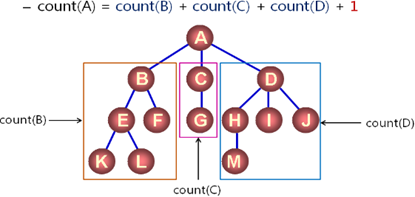1. The attribute operations in the tree are:
1, the number of nodes in the tree, the height in the tree, and the degree of the tree;
2. Number of nodes in the tree:


1, define function: count(node)
1. Count the number of nodes in the tree with node as the root node;
2, recursive implementation;
2. Function code implementation:
1 /* It is very delicate to find the number of nodes of the tree represented by the node as the root node */ 2 int count(GTreeNode<T>* node) const // Publicly owned count() Function is const function 3 { 4 int ret = 0; 5 6 if( node != NULL ) // If it is empty, it is directly the number of empty trees, 0; in the first case, if it is empty node No kids, then for Loop will not execute, return 1; 7 { 8 ret = 1; // There is at least one node. In the second case 9 10 for(node->child.move(0); !node->child.end(); node->child.next()) // The third situation 11 { 12 ret += count(node->child.current()); // The number of children owned by the current node, and then add up 13 } 14 } 15 16 return ret; 17 }
3. Implementation of node member function code in the tree:
1 int count() const
2 {
3 return count(root());
4 }
3. Height of tree:


1, define function: height(node)
Get the height of the tree whose node is the root node;
2, recursive implementation;
2. Function code implementation:
1 /* Recursive implementation of tree height with node as root node */ 2 int height(GTreeNode<T>* node) const 3 { 4 int ret = 0; 5 6 if( node != NULL ) // Empty tree height is 0 7 { 8 for(node->child.move(0); !node->child.end(); node->child.next()) 9 { 10 int h = height(node->child.current()); // Find the height of the current subtree 11 12 if( ret < h ) // Traverse to find the largest element 13 { 14 ret = h; 15 } 16 } 17 18 ret = ret + 1; // The height of the subtree plus the height of the root node is the height of the current tree, including two or three cases 19 } 20 21 return ret; 22 }
3. Tree height member function code implementation:
1 int height() const
2 {
3 return height(root());
4 }
4. Degree of tree:

1, define function: degree(node)
Get the degree of the tree whose node is the root node;
2, recursive implementation;
2. The tree degree function code is implemented:
1 /* Recursively implement the degree of tree with node as node */ 2 int degree(GTreeNode<T>* node) const 3 { 4 int ret = 0; 5 6 if( node != NULL ) // Empty tree degree is 0 7 { 8 ret = node->child.length(); // Number of root children 9 10 for(node->child.move(0); !node->child.end(); node->child.next()) 11 { 12 int d = degree(node->child.current()); // Degree of each subtree 13 14 if( ret < d ) // If the current degree is small, the newly calculated degree will be saved, which also includes the number of children of the root node. 15 { 16 ret = d; // ret Is the maximum degree, that is, the degree of the tree 17 } 18 } 19 } 20 21 return ret; 22 }
3, the tree degree function code is implemented:
1 /* Recursively implement the degree of tree with node as node */ 2 int degree(GTreeNode<T>* node) const 3 { 4 int ret = 0; 5 6 if( node != NULL ) // Empty tree degree is 0 7 { 8 ret = node->child.length(); // Number of root children 9 10 for(node->child.move(0); !node->child.end(); node->child.next()) 11 { 12 int d = degree(node->child.current()); // Degree of each subtree 13 14 if( ret < d ) // If the current degree is small, the newly calculated degree will be saved, which also includes the number of children of the root node 15 { 16 ret = d; // ret Is the maximum degree, that is, the degree of the tree 17 } 18 } 19 } 20 21 return ret; 22 }